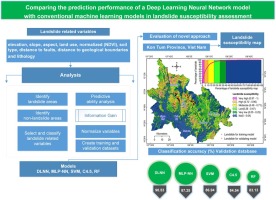Catena ( IF 5.4 ) Pub Date : 2020-01-10 , DOI: 10.1016/j.catena.2019.104426 Dieu Tien Bui , Paraskevas Tsangaratos , Viet-Tien Nguyen , Ngo Van Liem , Phan Trong Trinh

|
The main objective of the current study was to introduce a Deep Learning Neural Network (DLNN) model in landslide susceptibility assessments and compare its predictive performance with state-of-the-art machine learning models. The efficiency of the DLNN model was estimated for the Kon Tum Province, Viet Nam, an area characterized by the presence of landslide phenomena. Nine landslide related variables, elevation, slope angle, aspect, land use, normalized difference vegetation index, soil type, distance to faults, distance to geology boundaries, lithology cover, and 1,657 landslide locations, were used so as to produce the training and validation datasets during the landslide susceptibility assessment. The Frequency Ratio method was used so as to estimate the existing relation between the landslide-related variables and the presence of landslides, assigning to each variable class a weight value. Based on the results concerning the predictive ability of the landslide related variables which was evaluated using the Information ration method, all variables were further processed since they appear as highly predictive. The learning ability of the DLNN model has been evaluated and compared with a Multi Layer Preceptron Neural Network, a Support Vector Machine, a C4.5-Decision Tree model and a Random Forest model using the training dataset, whereas the predictive performance of each model has been evaluated and compared using the validation datasets. In order to evaluate their learning and predictive capacity of each model the classification accuracy, the sensitivity, the specificity and the area under the success and predictive rate curves (AUC) were calculated. Results showed that the proposed DLNN model had a higher performance than the four benchmark models. Although DLNN has been used seldom in landslide susceptibility assessments, the study highlights that the usage of deep learning approach could be considered as a satisfactory alternative approach for landslide susceptibility mapping.
中文翻译:

在滑坡敏感性评估中将深度学习神经网络模型与常规机器学习模型的预测性能进行比较
当前研究的主要目的是在滑坡敏感性评估中引入深度学习神经网络(DLNN)模型,并将其预测性能与最新的机器学习模型进行比较。DLNN模型的效率是针对越南贡通省(该地区以滑坡现象为特征)进行评估的。使用了9个滑坡相关变量,海拔,坡度,坡向,土地利用,归一化植被指数,土壤类型,到断层的距离,到地质边界的距离,岩性覆盖以及1,657个滑坡位置,以进行训练和验证。滑坡敏感性评估中的数据集。使用“频率比率”方法来估算滑坡相关变量与滑坡存在之间的现有关系,为每个变量类别分配一个权重值。根据使用信息定量方法评估的与滑坡相关变量的预测能力有关的结果,对所有变量进行了进一步处理,因为它们显示出很高的预测性。评估了DLNN模型的学习能力,并使用训练数据集与多层Preceptron神经网络,支持向量机,C4.5决策树模型和随机森林模型进行了比较,而每种模型的预测性能已使用验证数据集进行了评估和比较。为了评估它们对每种模型的学习和预测能力,计算了分类准确性,敏感性,特异性以及成功率和预测率曲线(AUC)下的面积。结果表明,所提出的DLNN模型具有比四个基准模型更高的性能。尽管DLNN在滑坡敏感性评估中很少使用,但该研究强调指出,深度学习方法的使用可以被视为滑坡敏感性测绘的令人满意的替代方法。











































 京公网安备 11010802027423号
京公网安备 11010802027423号